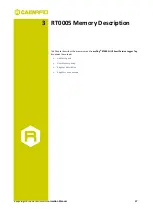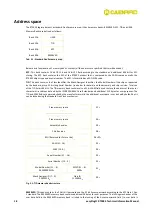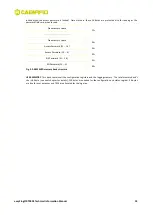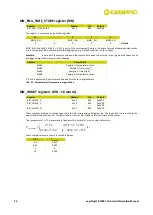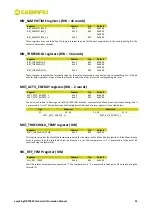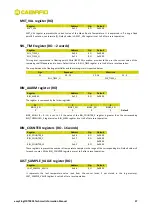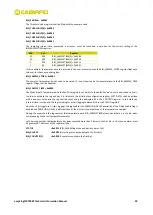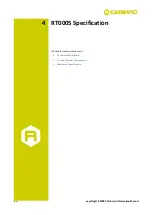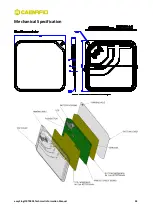
easy2log© RT0005 Technical Information Manual
18
Address space
The RT0005 tag implements a standard Gen2 memory map; it has 4 memory banks: RESERVED, EPC, TID and USER.
Memory Banks are defined as follows:
Bank 11b
USER
Bank 10b
TID
Bank 01b
EPC
Bank 00b
RESERVED
Tab. 3.1: Standard Gen2 memory map
Below a brief explanation of memory banks' content (all the address are specified 16bit word bounded):
EPC.
This bank contains 16 bit CRC-16 and 16 bit PC field according to the standard and additional 496 bit for EPC
storing. The EPC bank contains the EPC of the RT0005 product that is composed by the CAEN company prefix, the
RT0005 object type and a serial number. The EPC is formatted as a SGTIN-96 code.
TID.
This bank contains the Class Identifier, the Mask-Designer Identifier, the Model Number of the chip as requested
by the standard, plus a 32 bit long Serial Number (see below for details) and the assembly and chip revision. Total size
of the TID field is 64 bits. The TID memory bank contains also a 32 bit SAM field used to store the address of the sensor
characteristics table as defined by the ISO18000-6REV1 draft standard and additional 110 bytes for user purposes. The
TID and SAM fields are permalocked by the manufacturer while the additional user space is not locked by default but it
can be locked using the standard Gen2 lock mechanism.
Free memory space
3C
h
………………………………………….
Free memory space
0A
h
Assembly Revision
09
h
Chip Revision
08
h
RFU (Reserved for Future Use)
06
h
-07
h
SAM (31…16)
05
h
SAM (15…0)
04
h
Serial Number (31 … 16)
03
h
Serial Number (15 … 0)
02
h
Model Number (11 … 0)
000000000110
b
MDID (11 … 8)
0000
b
01
h
Mask Designer ID (7… 0)
00010010
b
Class ID
11100010
b
00
h
Fig. 3.1: TID memory bank structure
RESERVED
. This bank contains the 32 bit Kill password and the 32 bit Access password according to the EPC Class 1 Gen
2 standard. The RESERVED memory bank contains additional 56 bytes for user purposes. The locking mechanism of the
user data field in the RESERVED memory bank is linked to the locking of the Access password field (i.e. user data is














